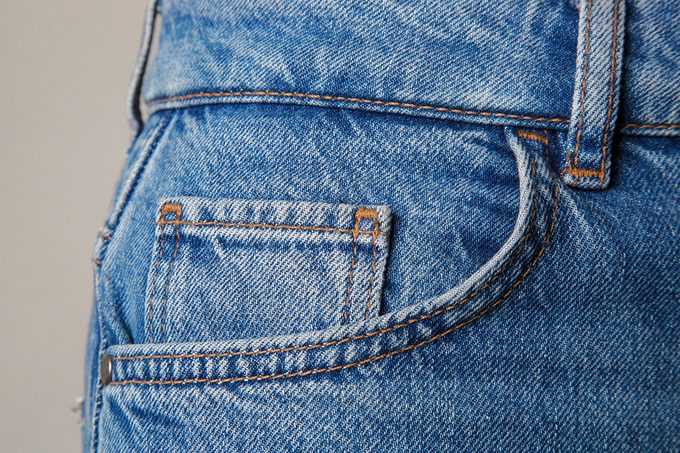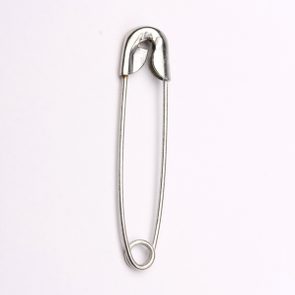Jeans have secrets. This one's tiny, historic and extremely bad at holding quarters. Here's the truth behind that little pocket on jeans.

This Is Why Jeans Have Those Tiny Pockets

There are a few mysteries in life we’ve just come to accept: why your Tupperware lids disappear, what your dog is thinking when it stares into the corner, and what the heck that little pocket on your jeans is actually for. I mean, it’s too small for a phone, too big for a breath mint, and too shallow for dignity if you try to squeeze a quarter in there.
Personally, I like to store lip balm in mine. I live in a high-plains desert, so lotion and lip balm are always on my person or I turn into the crypt keeper. But it turns out the tiny denim pocket isn’t just there to confuse you (or finger-trap you when you’re trying to dig something out). It’s a surprisingly historic feature that’s stuck around for more than a century.
“That little pocket you see stitched inside the right front pocket is a wonderful example of functional fashion and enduring heritage,” says Amanda Massi, a celebrity stylist with an MFA in fashion design and years of experience customizing denim. “I personally love them because it’s a reminder that great design stands the test of time, blending practicality and personality. That’s the magic of denim!”
And like many mysterious things sewn into clothing—looking at you, fake pockets in women’s blazers—this one actually has a legit purpose. We got the scoop straight from Massi and fellow experts Robert Ossant, a fashion historian and author, and Gary Firth, a textile specialist and managing director at Screen Textiles. Read on to find out everything you’ve always wanted to know about this little denim pocket.
Get Reader’s Digest’s Read Up newsletter for more fun facts, humor, travel, tech and cleaning all week long.
Why is there a little pocket on jeans?
Here’s the fascinating fact you’ve been waiting for: The tiny pocket, often called the “fifth pocket,” isn’t just Levi’s being extra. It was originally designed to hold a very specific accessory: the pocket watch. And not just because cowboys needed to know when it was high noon.
Back when wristwatches weren’t yet a thing, men carried their watches on chains, tucked into a vest or a small trouser pocket, Massi explains. So when Levi Strauss came along with the world’s strongest trousers, it only made sense to include a handy watch pocket.
“Jeans started off not as fashion clothing but as clothing for workmen, farmers, cowboys and other manual laborers,” Firth says. “And to prevent the workers’ wristwatches from getting damaged, [jeans] were designed with a small place to store their ‘pocket watch.'”
So, basically, that teeny pocket was the 1800s version of an Apple Watch protector.
Ironically, Ossant adds, “this coincided with a trend across all male fashion to add more and more pockets to clothing, while simultaneously removing them from women’s fashions.” (And thus began the great feminist uprising known as We Want Pocketssss, now in its 147th year and still tragically underfunded.)
What is the small pocket on jeans used for?
These days, most people use it for, well, whatever fits. A stick of gum. A guitar pick. One AirPod (but not both—never both). Some folks swear it’s perfect for their Zippo lighter or rogue memory card.
“Although the original use was for a pocket watch, today there are many uses for that small pocket, from storing tissues, cart coins, lighters and a house key,” Firth says.
But its glory days were all about timekeeping.
What’s the origin of the little pocket on jeans?

To truly appreciate the watch pocket, you’ve got to travel back a few centuries (and across the ocean) for a history lesson. While jeans are as American as apple pie or a dude grilling hot dogs in flip-flops, their roots are surprisingly European. “The material we now call denim, used in jeans, actually dates back to the 16th century in southern France,” Ossant explains. “The André family, residents in the city of Nîmes, invented, iterated and produced a canvas material from cotton that was a hard-wearing, multipurpose textile.”
So, yes, your distressed skinny jeans are descended from French ship sails. Très chic.
“It’s from De Nîmes—literally ‘of Nîmes’—that we get the word denim, and from Bleu de Gênes, we get blue jeans,” Ossant adds.
In 1873, Levi Strauss, a German immigrant to the U.S., took this ultra-rugged fabric and—with the help of a tailor named Jacob Davis—added rivets to strengthen the seams, making the world’s first jeans. (They were originally called waist overalls, according to Firth, which honestly sounds like something a toddler would wear to a hoedown).
And technically? It was never the “fifth pocket” at all. “The little watch pocket is often called the fifth pocket, but, in fact, it was the fourth,” says Ossant. Early Levi’s jeans originally had two front pockets and one back pocket. The watch pocket was added around 1879, making four. The final fifth pocket, the second back pocket, was added in 1901.
Fun facts about the little pocket on jeans
Here are some big facts about this tiny pocket:
- It has many nicknames. It’s been called the watch pocket, coin pocket, ticket pocket, condom pocket (hi, 1970s), lighter pocket and, in some circles, the “useless little pocket thingy.” Over in the U.K., its nickname is “fob pocket”—short for “watch fob,” which is the traditional name for the strap or chain that holds a pocket watch. So, yes, your jeans have a British accent.
- It briefly had a flap. In early iterations, some jeans brands added a button flap to the watch pocket to keep the timepiece extra secure. It didn’t stick around (tiny buttons are fiddly), but the idea was peak 19th-century security.
- Levi’s still calls it the “watch pocket.” Even though most of us haven’t touched a pocket watch since we last played Clue (the Downton Abbey version), Levi Strauss & Co. still officially refers to that little pocket as the watch pocket, not the coin pocket.
- It’s survived 150-plus years of fashion trends. Skinny jeans, low-rise jeans, cargo jeans, JNCOs, acid wash, jeggings—the mini pocket has outlasted them all like a stubborn denim cockroach. Respect.
- Jeans were patented before the light bulb. Levi Strauss & Co. got its patent for riveted denim trousers in 1873. Edison didn’t patent the light bulb until 1880. Jeans literally came before electricity.
- That tiny pocket used to be deeper. In early designs, the watch pocket was slightly larger to better fit bulky 19th-century timepieces.
- It’s still stitched to last. Even though it’s no longer essential and most people don’t use it, denim brands still double-stitch the mini pocket like it’s protecting the crown jewels.
- It’s not just Levi’s. Most major denim brands keep the watch pocket as part of classic jean construction—even on women’s jeans, where functional pockets are often mythical creatures.
How do people use the little pocket on jeans now?
Despite the fact that most of us don’t carry pocket watches anymore (unless you’ve recently time-traveled from the Victorian era), the watch pocket remains. Today, the little pocket is mostly a nostalgic design nod, and most people don’t actually use it. But for denim lovers, it’s also a reminder of the garment’s working-class roots—and its evolution from gritty tool to everyday fashion staple, Massi says.
So next time you notice that tiny pocket, take a moment to thank it for its service. And maybe store something in it—think: something small, meaningful, not pointy, and unlikely to fall out when you sit down. Like your favorite rock. A tooth for the tooth fairy. A crumpled concert ticket. A single jelly bean. Or the single Barbie shoe my kid handed to me mid–Target trip like it’s a priceless heirloom (which it is).
About the experts
|
Why trust us
At Reader’s Digest, we’re committed to producing high-quality content by writers with expertise and experience in their field in consultation with relevant, qualified experts. We rely on reputable primary sources, including government and professional organizations and academic institutions as well as our writers’ personal experiences where appropriate. For this piece on the little pocket on your jeans, Charlotte Hilton Andersen tapped her experience as a longtime journalist who specializes in common curiosities, etiquette and communication for Reader’s Digest. We verify all facts and data, back them with credible sourcing and revisit them over time to ensure they remain accurate and up to date. Read more about our team, our contributors and our editorial policies.
Sources:
- Amanda Massi, celebrity stylist; phone interview, June 11, 2025
- Robert Ossant, fashion historian and author of The Art of Couture Embroidery: The Secrets of Runway Design; email interview, June 14, 2025
- Gary Firth, textile specialist and managing director at Screen Textiles; email interview, June 12, 2025























